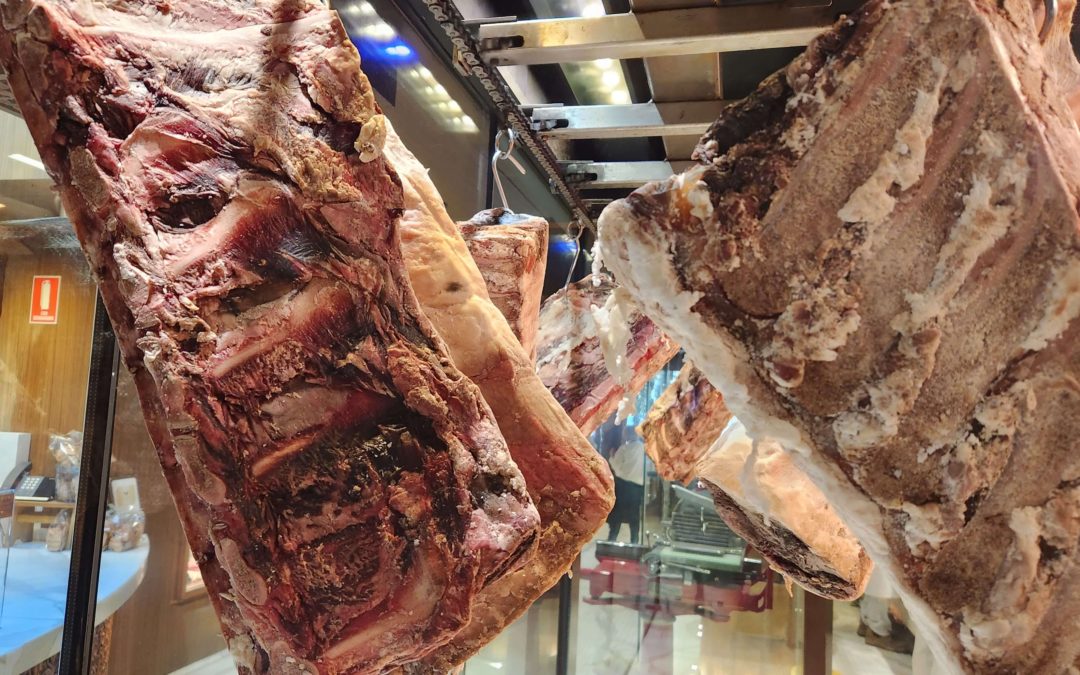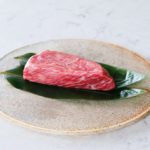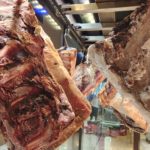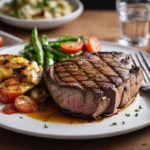Ever found yourself lost in the sea of steak options lining the meat aisle? You’re not alone. Navigating through the array of cuts can often feel like a maze, particularly when it comes to choosing one for that special dinner.
Take the porterhouse steaks, for instance – did you know they carry an impressive title as “the king of T-bones“? And here’s another savory tidbit: dry aging these princely pieces enhances their lush flavors and tenderness, transforming your ordinary dinner into something downright gourmet.
Excited yet? Stay with us as we slice away at this tasty topic and give you everything you need to know about Dry Aged Porterhouse!
Key Takeaways
- Dry aging is a special process that makes meat taste better and feel softer by hanging it in a clean room with cool air for about 30 days or more.
- Dry aged porterhouse steak is tender, flavorful, and juicy due to the dry aging process. It combines the tenderness of filet mignon with the bold flavor of NY strip.
- To cook dry aged porterhouse, preheat a skillet, season the steak with salt and pepper, sear it on both sides, then finish cooking in the oven. Let it rest before slicing for maximum flavor.
- When serving dry aged porterhouse, pair it with red wines like Cabernet Sauvignon or Malbec and complement it with side dishes like creamed spinach or roasted garlic mashed potatoes.
What is Dry Aging?
Dry aging is a process where beef, like porterhouse steak, is hung or placed on racks in a controlled environment to allow the natural enzymes in the meat to break down and tenderize it.
Definition and process of dry aging
Dry aging is a special way to make meat taste better and feel softer. We place the meat in a very clean room with cool air. The air moves all around it for many days. This makes the water in the meat go away and gives more flavor to it.
Meat from stores usually ages for only 7-10 days, but dry aging takes longer, about 30 days or even more. It’s an old process that goes back to the 1950s! You may find machines on sale that can help you dry age at home too! But know this – eating dry-aged beef could have some health risks, so be careful when you eat it often.
Benefits of dry aging for porterhouse steak
Dry aging gives a porterhouse steak some great benefits. First, it makes the steak tender and easy to chew. The dry-aged process also brings out a bold flavor that is loved by many meat lovers.
It works like magic on tough cuts of beef like the rib-eye and makes them soft.
Another big perk is that dry-aging adds juiciness to the porterhouse steak. You will bite into it and taste a world of richness! Plus, with all these tasty perks, you are getting top-notch quality beef.
Your order for dry aged porterhouse comes from skilled butchers who use only the highest grade meat.
So there you go! This special way of treating the steak does make your meal more delightful.
Why Choose Dry Aged Porterhouse?
Dry aged porterhouse is the ultimate choice for steak lovers, offering superior flavor and tenderness, intense marbling, and the perfect combination of filet mignon and NY strip cuts.
Superior flavor and tenderness
Dry aged porterhouse shines with its great taste and softness. This kind of steak gets better as it ages. Dry aging lets the beef’s natural enzymes break down hard muscle tissue. Think of this like a time machine for flavor! The longer you dry age, the more rich, deep beef taste you get.
Plus, your steak becomes super tender to bite into. Your tastebuds will dance with joy at each juicy mouthful!
Intense marbling and juiciness
Dry-aged porterhouse steak is renowned for its intense marbling and juiciness. The process of dry aging allows the fat within the meat to evenly distribute, resulting in beautiful marble patterns throughout the cut.
This marbling not only enhances the flavor but also contributes to a tender and juicy eating experience. With each bite, you can savor the rich flavors that are locked within the meat, making dry-aged porterhouse steak a top choice for meat lovers seeking ultimate indulgence.
Combination of filet mignon and NY strip cuts
Dry-aged porterhouse steak is truly the best of both worlds because it combines two mouthwatering cuts of beef: the tender filet mignon and the flavorful NY strip. The filet mignon is known for being the most tender cut of beef, while the NY strip offers a robust flavor that meat lovers crave.
By having both cuts in one steak, you get to experience tenderness and boldness in every bite. It’s like getting two steaks in one! So when you indulge in a dry-aged porterhouse, you’re treating yourself to a delicious combination that will leave your taste buds dancing with delight.
How to Cook Dry Aged Porterhouse
To cook dry aged porterhouse, start by preheating a cast-iron skillet over high heat. Season both sides of the steak generously with salt and pepper. Place the porterhouse in the hot skillet and sear for about 2-3 minutes on each side to develop a crust.
Then, transfer the skillet to a preheated oven at 400°F (200°C) and continue cooking for about 6-8 minutes for medium-rare doneness. Let it rest for 10 minutes before slicing against the bone to serve.
Recommended cooking methods and temperatures
To enjoy the perfect dry-aged porterhouse steak, follow these cooking methods and temperatures:
- Preheat your grill or cast-iron skillet to medium-high heat.
- Season the steak generously with salt and pepper.
- Place the steak on the hot grill or skillet, searing it for 3-4 minutes on each side for a medium-rare doneness. Adjust the time according to your desired level of doneness.
- Use a meat thermometer to ensure the internal temperature reaches 130°F (54°C) for medium-rare, 140°F (60°C) for medium, or 150°F (65°C) for well-done.
- Remove the steak from the heat and let it rest for about 5 minutes before slicing.
- To achieve those beautiful grill marks, rotate the steak halfway through cooking on each side.
Tips for achieving the perfect sear and doneness
To achieve the perfect sear and doneness for your dry aged porterhouse steak, follow these tips:
- Preheat your grill or cast – iron skillet to high heat.
- Let the steak come to room temperature before cooking.
- Pat the steak dry with paper towels to remove any excess moisture.
- Generously season both sides of the steak with salt and pepper.
- Place the steak on the hot grill or skillet and let it cook undisturbed for a few minutes to develop a nice sear.
- Flip the steak and continue cooking until it reaches your desired level of doneness:
- For medium – rare, cook until the internal temperature reaches 135°F (57°C).
- For medium, cook until the internal temperature reaches 145°F (63°C).
- Adjust cooking times based on thickness and personal preference.
- Use a meat thermometer to ensure accurate doneness.
- Once cooked, let the steak rest for 5 – 10 minutes before slicing. This helps retain its juices.
- Slice against the grain for maximum tenderness.
Resting and slicing techniques
Resting and slicing your dry aged porterhouse steak correctly is crucial to ensure optimal flavor and tenderness. After cooking, allow the steak to rest for about 5-10 minutes before slicing.
This allows the juices to redistribute throughout the meat, resulting in a more juicy and flavorful eating experience. When it comes to slicing, use a sharp knife and cut against the grain for maximum tenderness.
The grain refers to the lines of muscle fibers running through the steak. Slicing against these lines helps break up those fibers, making each bite more tender and easier to chew. So remember, let your dry aged porterhouse steak rest before cutting into it, then slice against the grain for a mouthwatering dining experience!
Pairings and Serving Suggestions
When it comes to pairing and serving your dry aged porterhouse, we’ve got you covered. From wine and beer pairings to recommended side dishes and sauces, we’ll help you create the perfect culinary experience.
So let’s dive in and discover the delicious possibilities of enjoying your dry aged porterhouse steak!
Wine and beer pairings
For those who love meat, pairing the right wine or beer with your dry aged porterhouse can elevate your dining experience. Here are some suggestions to complement the rich flavors of your steak:
- Red wines such as Cabernet Sauvignon or Merlot: These bold and full-bodied wines match well with the robust flavors of a dry aged porterhouse.
- Malbec: This red wine is known for its fruity notes and smooth finish, making it a great choice to balance out the richness of the steak.
- Syrah/Shiraz: With its peppery undertones and medium to full body, Syrah or Shiraz can enhance the smoky flavors of a perfectly seared dry aged porterhouse.
- Craft beers such as IPA (India Pale Ale) or Stout: The hoppy bitterness of an IPA can cut through the richness of the steak, while a dark and creamy Stout can complement its intense flavors.
Recommended side dishes and sauces
When enjoying a delicious dry-aged porterhouse steak, it’s important to complement the rich flavors with the perfect side dishes and sauces. Here are some mouthwatering options:
- Creamed spinach: This classic steakhouse side dish is creamy, flavorful, and pairs perfectly with the bold flavors of a dry-aged porterhouse.
- Roasted garlic mashed potatoes: The creamy texture and subtle garlic flavor of mashed potatoes make them an ideal accompaniment to a juicy steak.
- Grilled asparagus: Lightly charred and tender asparagus spears add a touch of freshness to your meal while providing a healthy balance to the hearty steak.
- Sauteed mushrooms: Earthy and savory, sauteed mushrooms bring out the deep umami flavors of the dry-aged porterhouse.
- Baked macaroni and cheese: Indulge in comfort food bliss by serving up a cheesy, gooey mac and cheese alongside your steak.
- Chimichurri sauce: This vibrant green sauce made with fresh herbs, garlic, olive oil, and vinegar adds brightness and tanginess to each bite of your steak.
- Peppercorn sauce: A rich and velvety sauce with cracked black pepper adds complexity and a touch of spice to enhance the flavors of your dry-aged porterhouse.
Presentation and plating ideas
When it comes to presenting and plating your dry-aged porterhouse steak, there are many creative options to impress your guests. Here are some ideas:
- Keep it simple: Place the perfectly cooked porterhouse steak on a clean white plate for an elegant and classic presentation.
- Get fancy with garnishes: Add a sprig of fresh herbs, such as rosemary or thyme, on top of the steak for a touch of greenery and aroma.
- Add color with roasted vegetables: Arrange colorful roasted vegetables, like bell peppers and carrots, around the steak for a vibrant and nutritious side dish.
- Make it rustic: Serve the dry-aged porterhouse steak on a wooden platter or cutting board for a rustic and down-to-earth presentation that highlights the meat’s natural beauty.
- Dress it up with sauces: Drizzle your favorite sauce over the sliced porterhouse steak for added flavor and visual appeal. Classic choices include peppercorn sauce or red wine reduction.
- Create height with stacked potatoes: Stack thinly sliced crispy potatoes next to the steak to give your plate some vertical elevation and texture contrast.
- Serve with crusty bread: Accompany your dry-aged porterhouse steak with warm and crusty artisan bread to soak up all those delicious juices.
- Use edible flowers as decoration: Sprinkle edible flowers, like nasturtiums or pansies, around the plate to add a touch of elegance and whimsy.
Where to Buy Dry Aged Porterhouse
You can find dry aged porterhouse at online retailers, specialty butcher shops, and local restaurants or steakhouses. Consider the cost and quality when choosing where to purchase this gourmet cut of beef for your next special occasion.
Online retailers and specialty butcher shops
You can easily find dry aged porterhouse steak from these places:
- Online retailers like Crowd Cow, Snake River Farms, and Porter Road.
- Specialty butcher shops such as Pat LaFreida Meat Purveyors and The Butcher’s Market.
- Considerations for cost and quality: Look for deals and discounts, read customer reviews, and check if the beef is USDA Prime.
- Dry aging machines and equipment are available for the dry aging process.
- There may be health risks associated with consuming dry – aged beef.
Local restaurants and steakhouses

We know that sometimes you just want to sit back and let the experts handle the cooking. That’s why we’re here to tell you about some local restaurants and steakhouses where you can find delicious dry-aged porterhouse steaks. Trust us, these places are a meat lover’s dream come true! Check out these options:
- The Steakhouse: Step into this classic steakhouse for a dining experience like no other. Their dry-aged porterhouse steak is cooked to perfection, with an unbeatable sear on the outside and juicy tenderness on the inside.
- BBQ Joint: Looking for a more casual setting? This BBQ joint knows how to do it right. Their dry-aged porterhouse steak is smoked low and slow, giving it a rich and smoky flavor that will have your taste buds singing.
- Fine Dining Restaurant: For those special occasions or when you just want to treat yourself, head to this fine dining restaurant. Their dry-aged porterhouse steak is served with all the gourmet fixings, making it a meal fit for a king (or queen).
- Local Pub: Don’t think that only fancy restaurants can serve up amazing steak. This local pub knows their way around a grill. Their dry-aged porterhouse steak is cooked over an open flame, giving it that perfect charred flavor that we all love.
- Family-Owned Steakhouse: If you’re looking for a place with character and charm, look no further than this family-owned steakhouse. They take pride in their dry-aged porterhouse steak, serving up generous portions with all the classic sides.
Considerations for cost and quality
When it comes to buying dry-aged porterhouse steak, there are a few things to consider for cost and quality. First, be prepared that dry-aged meat can be more expensive than regular cuts of beef.
This is because the aging process takes time and requires special conditions. However, the extra cost is worth it for the superior flavor and tenderness you get with dry-aged steak.
To ensure you’re getting the best quality, look for reputable retailers or specialty butcher shops that offer dry-aged porterhouse steak. They should have positive customer reviews and prioritize sourcing high-quality prime beef.
If cost is a concern, consider buying in bulk or looking for sales or promotions. You can also check if local restaurants or steakhouses offer dry-aged porterhouse on their menu. Lastly, if you’re feeling adventurous, you can try your hand at DIY dry aging at home using proper equipment and following recommended safety precautions.
DIY Dry Aging at Home
To dry age porterhouse steak at home, all you need are some basic equipment, like a refrigerator and a wire rack, along with some patience. Find a prime cut of porterhouse steak and carefully wrap it in cheesecloth to allow for proper airflow.
Place the wrapped steak on the wire rack in your refrigerator and let it age for several weeks, checking regularly for any signs of spoilage. Remember to maintain humidity levels and temperature control throughout the process.
With some time and effort, you can enjoy the exceptional flavors of dry aged porterhouse right in the comfort of your own kitchen.
Equipment and steps for dry aging steak at home
Dry aging steak at home is a fun and rewarding project for meat lovers. Here is what you need to get started:
- A good quality piece of beef: Choose a well-marbled steak like a porterhouse or rib-eye.
- Dry-aging bags: These specially designed bags allow the meat to breathe while protecting it from contamination.
- A refrigerator: You’ll need a dedicated space in your fridge for the dry aging process.
- Wire rack or tray: This helps air circulation around the meat and prevents moisture buildup.
- Thermometer: Use a digital thermometer to monitor the temperature inside the fridge.
- Clean and prep: Rinse the steak under cold water, then pat it dry with paper towels.
- Place in bag: Put the steak into a dry-aging bag, removing any excess air before sealing it tightly.
- Store in fridge: Put the bagged steak on a wire rack or tray inside your fridge. Make sure there is enough space around it for proper airflow.
- Monitor temperature: Keep an eye on the temperature inside the fridge using a digital thermometer. It should be around 34°F to 38°F (1°C to 3°C).
- Aging time: The ideal aging time depends on personal preference but generally ranges from 14 to 28 days.
- Check regularly: Open the fridge occasionally to check on the meat and ensure there is no mold growth or off odors.
- Trim before cooking: Once you reach your desired aging time, remove the steak from the bag and trim off any dried outer layers before cooking.
Safety precautions and recommended aging times
To ensure the safety of your dry aging process at home, it is important to follow some precautions. Keep in mind that there may be health risks associated with consuming dry-aged beef.
It’s recommended to use high-quality, USDA prime porterhouse steak for dry aging. Make sure you have a dedicated refrigerator or an aging machine specifically designed for this purpose.
Maintain proper hygiene by cleaning and sanitizing all surfaces and equipment used for handling the meat. It’s also crucial to monitor temperature and humidity levels throughout the aging period to prevent bacterial growth.
As for the recommended aging times, it varies depending on personal preference and desired flavor profile. Generally, dry-aged steaks are aged between 30-45 days to achieve optimal tenderness and flavor development.
The longer the meat ages, the more intense its flavor becomes.
Common challenges and troubleshooting tips
Dry aging meat can sometimes present challenges, but with a few tips and tricks, you’ll be able to overcome them and enjoy delicious dry-aged porterhouse steaks. Here are some common challenges and troubleshooting tips for dry aging at home:
- Mold Growth: During the aging process, mold can develop on the surface of the meat. This is normal and can be easily remedied by trimming off the affected area before cooking.
- Moisture Control: Proper humidity levels are crucial for successful dry aging. If you’re experiencing too much moisture, make sure your aging environment is well-ventilated and consider using a dehumidifier. On the other hand, if it’s too dry, you can place a damp cloth or sponge in your aging chamber to increase humidity.
- Temperature Fluctuations: Consistent temperature is essential for safe and effective dry aging. If your refrigerator or dedicated aging fridge is not maintaining a steady temperature, use a reliable thermometer to monitor it closely and make any necessary adjustments.
- Time Management: Dry aging takes patience as it can range from 21 days to several weeks or even months depending on personal preference. Keep track of the time meticulously so that you don’t over-age your steaks.
- Odor Control: Dry-aged beef develops a unique aroma that some people find strong. To minimize this smell in your refrigerator or dedicated aging space, place an open container of baking soda or coffee grounds nearby to absorb odors.
Conclusion
In conclusion, dry-aged porterhouse steak offers meat lovers a truly exceptional dining experience. The process of dry aging enhances the tenderness and flavor of the beef, resulting in a juicy and delicious cut of meat.
Whether you choose to enjoy it at a restaurant or try your hand at DIY dry aging at home, the rich and robust flavors of dry-aged porterhouse are sure to satisfy even the most discerning palate.
So go ahead, treat yourself to this premium steak – you won’t be disappointed!
FAQs
1. What is a dry-aged USDA prime porterhouse steak?
A dry-aged USDA prime porterhouse steak is one of the highest quality beef cuts. It combines the tenderness of a loin with the taste-stuffed ny strip.
2. How is a porterhouse cut different from other steaks?
The porterhouse has two different steaks in one, joined by a t-shaped bone. The mignon, being most tender and flavorful, combined with new york strip makes it unique.
3. How does the process of dry-aging work?
Dry-aging process takes up to 48 hours under meticulous control; It adds nutty flavor while boosting beef’s natural savoriness.
4. Can I order this Dry Aged Porterhouse Steak online?
Yes! You can order online the perfect steak for pickup or have it ship to you packed securely with gel packs ensuring it never gets frozen.
5. What makes these pasture-raised beefs special?
These pasture-raised beafs are antibiotic-free and hormone-free that add bonus flavor when vegetarian fed making them best served as they are best of the best in quality.
6. Is there any special way to serve this type of steak?
Let your perfectly cooked 32 oz dry-aged usda prime portehouse rest about ten minutes before serving will ensure expected flavors release making every bite delicious.
Greetings!
With over two decades of diverse experience in the meat industry, I proudly stand as an expert in all things meat. My journey commenced with a strong foundation in hospitality, where I honed my culinary skills as a chef in prestigious restaurants and on luxurious superyachts worldwide.
However, my true passion lies in the art of butchery. Throughout my extensive career, I have had the privilege of working with renowned meat purveyors and mastering the craft of meat cutting and preparation. From breaking down whole carcasses to meticulously selecting prime cuts, my butchery expertise is at the core of my meat knowledge.
Having immersed myself in various cultures and cuisines, I have honed my skills to deliver exceptional dining experiences, crafting delectable dishes that celebrate the natural flavors of different meats. Whether it's sourcing the finest meats for discerning clients or sharing valuable tips on meat selection and cooking, I take pride in elevating the meat experience for both professionals and enthusiasts.
My journey has taken me from the bustling kitchens of top-rated restaurants to the heart of meat processing facilities, gaining insights and honing my skills to become a true meat connoisseur. Now, I am enthusiastic about sharing my expertise, offering valuable insights on meat selection, cooking techniques, and the art of butchery.
















